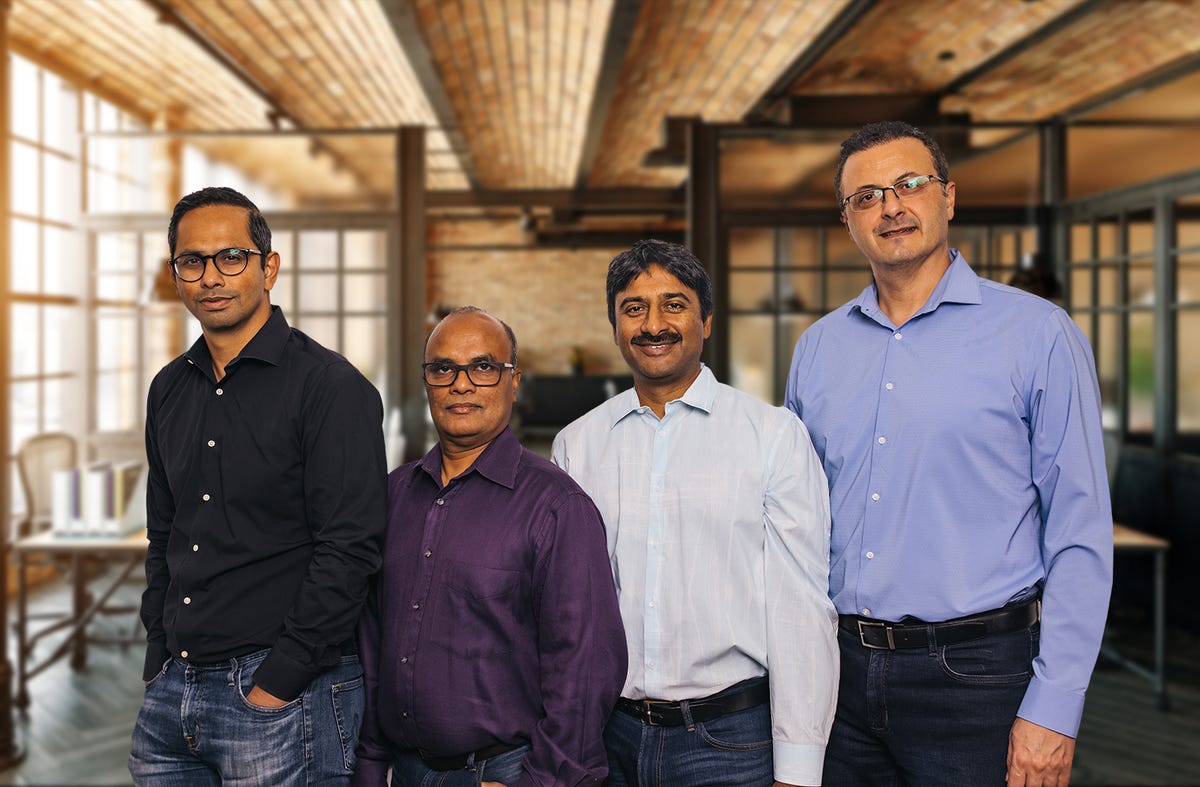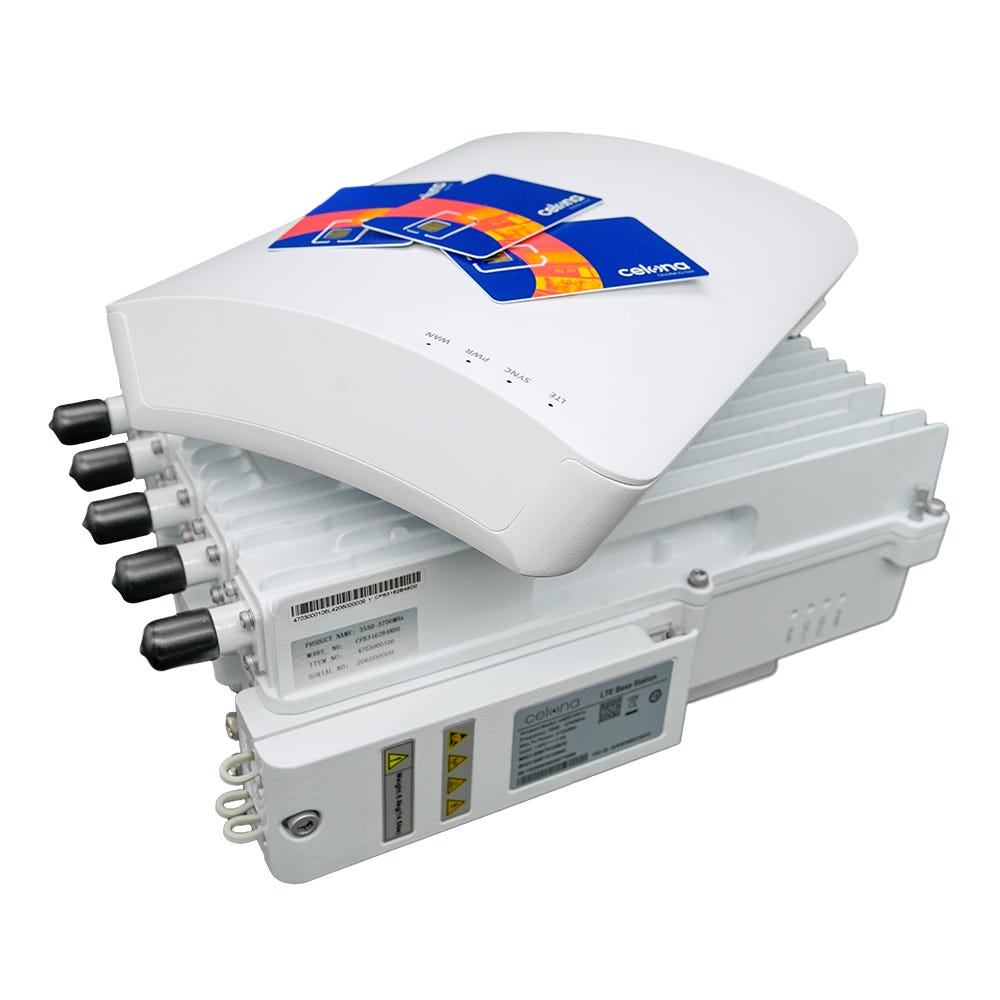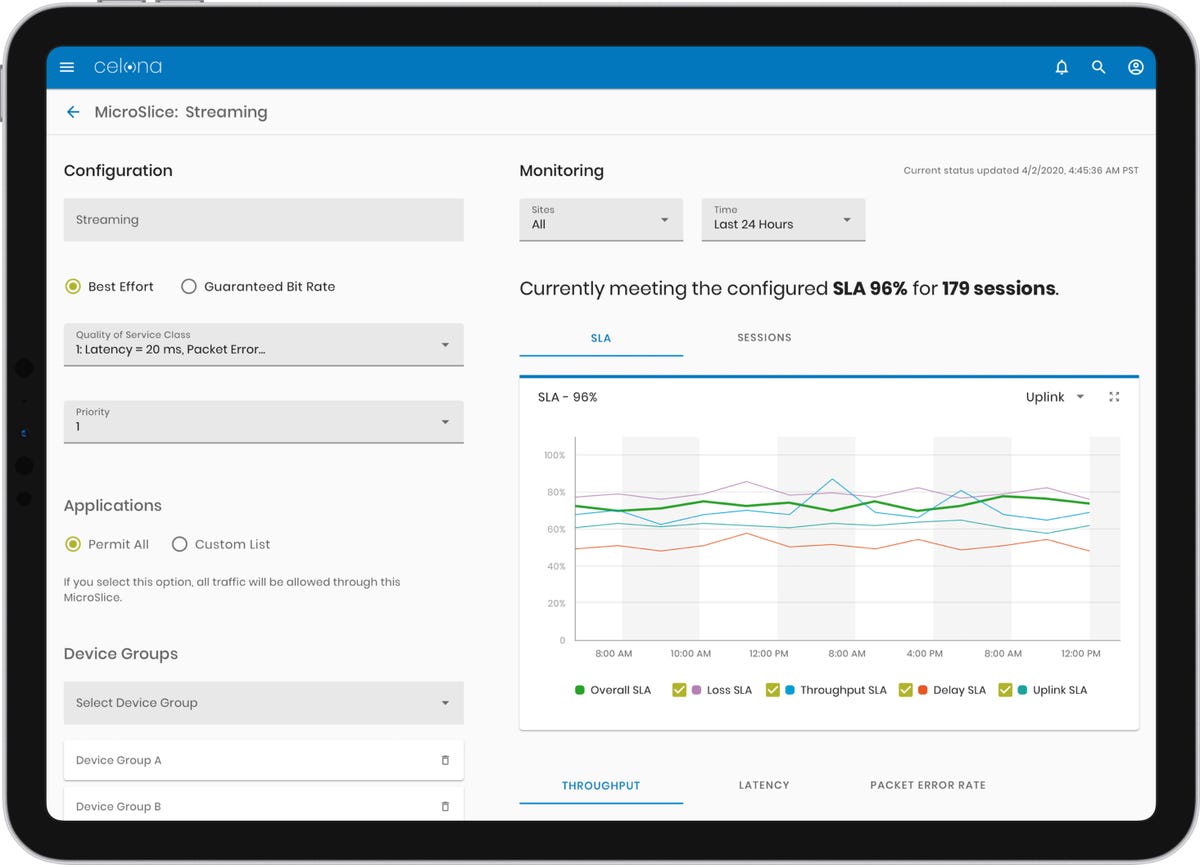
Celona founders, from left, Rajeev Shah, CEO, Ravi Mulam, founding engineer, Vinay Anneboina, founding engineer, and Mehmet Yavuz, CTO.
Celona
The common conception of 5G wireless service is as a faster radio connection for laptops and smartphones, multiple gigabits over the air. But you may need to revise most everything you think about 5G to understand its true significance.
For enterprises, which are increasingly interested in using 5G indoors, as a networking technology, one of the most important aspects of 5G is that it is about structuring the network for defined service in a way that could never be done before. That aspect of the matter, which is largely about software, means that 5G is much more than a radio upgrade.
It could, in fact, bring significant change to the way that software runs networking for corporate LANs.
“Nokia and Ericsson and Cisco are in the middle of an interesting transition,” said Özer Dondurmacioğlu, who is vice president of technical marketing for two-year-old startup Celona, in an interview with ZDNet via Zoom.
“For them, transitioning to 5G feels just like a radio transition, but the software architecture is completely changing,” says Dondurmacioğlu. “They are in the middle of this big, invisible software architecture revolution.”
That software revolution is how Celona expects to make an end-run around Cisco and others. The startup is a young contender in a broad movement to bring 5G to enterprises as a supplement to, and sometimes a replacement for, WiFi-based wireless LANs.
Celona has received $40 million in venture capital financing from top funds, including Lightspeed, Norwest, In-Q-Tel, Cervin Ventures, the venture capital arm of wireless chip giant Qualcomm, and the venture capital arm of Japan’s giant telco NTT.
A Series B round of funding last year brought in $30 million in one fell swoop.
Also: Dish makes deals with Equinix, Cisco to build out 5G network
Celona started selling equipment a year ago. The Cupertino California-based company this past year opened a small engineering facility in Bangalore. The company employs 85 people in total at the moment.
What is key for Celona is that rather than sell telco software, it is offering software with an enterprise focus, software meant to be used by CIOs and sys admins. The company views itself as righting the wrongs of both WiFi wireless LANs as well as traditional private networks built on cellular spectrum.
“The private LTE market has been around for a while,” Dondurmacioğlu observed, “and they have been doing one thing quite wrong.” Those traditional parties have tried to “just sell their existing infrastructure” to enterprise with no accommodation for how enterprises run.
To Dondurmacioğlu, who is of Turkish descent, that is the equivalent of “putting some yogurt on a burger” rather than creating “proper Mediterranean food.”
Dondurmacioğlu, and Celona’s chief technologist, Mehmet Yavuz, who took part in the same interview via Zoom, are veterans of the enterprise LAN and telco domains. Dondurmacioğlu was a vice president with Aruba, the wireless LAN unit of Hewlett Packard Enterprise, for fourteen years. Yavuz, who started his career at telco equipment giant Nortel, was vice president of engineering at Qualcomm for almost fifteen years.
Celona’s CEO, Rajeev Shah, was also an Aruba exec for eleven years.
Both Dondurmacioğlu and Yavuz see what WiFi and what private cellular each failed to achieve. While improving the corporate wireless LAN, Celona’s technology aims to fulfill the premise of private cellular, namely, more selective control of the network, the same way that a carrier is able to structure their wide-area network for quality of service.

Celona’s 5G access points.
Celona
Also: 6 things businesses can do right now to leverage 5G
“It’s just designed to equate to WLAN,” said Yavuz of the company’s 5G LAN. “There is LAN, there is WLAN, which is WiFi, and there is 5G LAN, and they are all part of the enterprise LAN family.”
Switch equipment from Celona will use 5G frequencies below 6 gigahertz, a part of the so-called S Band of spectrum that is licensed by the FCC for broad commercial use, known as the CBRS, or Citizens Broadband Radio System.
With Celona’s access points, companies can carefully structure their networks so that individual network services will have a kind of guaranteed private lane to operate with quality of service assurances. The switch registers with what’s known as a spectrum access system, or SAS, a cloud-based server that manages access to the spectrum by CBRS client devices.
The SAS server is a hosted service provided by Google and others including Arlington, Virginia-based cloud provider Federated Wireless.

Celona management console.
Celona
Prior to operation, the SAS service has to be certified by the U.S. Federal Communications Commission. Celona ships its products bundled with a SAS license from either Google or Federated. When the products are installed, a Celona network then requests authorization from the SAS service for private spectrum access for all the access points.
As a result of the SAS approach, the cellular frequencies of CBRS, like cellular networks generally, have freedom from interference that was never assured with wireless LANs using WiFi.
“I worked on some pretty interesting WiFi deployments at Aruba,” recalled Dondurmacioğlu. “I always had to contend with interference from my neighbor networks, and from within the network itself,” he said. “I would deploy 28 devices in a hospital, I had to make sure they don’t interfere with each other through some terrible channel planning, and then that my neighbors don’t interfere with me.”
Also: 5G’s biggest benefits will arrive where you’d least expect them
“I don’t have that problem with cellular — by design,” he said. Cellular schedules all traffic flows between all devices on the network. “The concept of radios stepping over each other is gone.”
Not only is interference banished by the SAS, but the QOS for every service is rigorously enforced with cellular. What that means, and what is lost in the many press releases from Cisco and Dish and others, is that 5G is not just about speed, a faster radio. More important than speed, 5G is about latency, the longest delay in sending a bit of data from point A to point B.
In his Aruba projects, “We never were able to guarantee a service level,” Dondurmacioğlu recalled. “I could say that this video traffic goes before this data traffic,” but he could not guarantee a certain number of megabits would be actually given to the video stream. That kind of allocation of bits is, again, by design available in cellular.
When Celona talks to enterprises about lack of interference and about rigorous QOS, “They go, yeah, we were never able to do that,” he said, “and they want to talk about how they can start doing that.”
CBRS is just one band at the moment, approximately 3.5 gigahertz to 3.7 gigahertz. The 150 megahertz of spectrum afforded in that band is more than enough to cover the needs of most corporate offices, said Yavuz.

“I worked on some pretty interesting WiFi deployments at Aruba,” Özer Dondurmacioğlu, Celona’s vice president of technical marketing, recalls. “I always had to contend with interference from my neighbor networks […] We never were able to guarantee a service level […] I don’t have that problem with cellular — by design.”
Celona
“The way we look at it is, sub-6 [gigahertz] is a really solid solution in enterprise for both indoor and outdoor coverage,” said Yavuz. “It can cover a large range.”
Also: 5G isn’t quite there, and MixComm believes it has the millimeter wave fix
For specific use cases, said Yavuz, one can supplement S Band with higher-frequency millimeter wave technology, an area of the electromagnetic spectrum that some believe will be very important for 5G over time.
As much as cellular transforms wireless LAN, on the flip side, Celona believes it can be enterprise-friendly in ways telcos never could with LTE.
Yavuz spent years at Qualcomm working with the carriers. “My passion was to bring that cellular technology to enterprise” when he ran the so-called small cells effort at Qualcomm, Yavuz recalled. “From the hardware perspective, Qualcomm did a lot of work to make SoCs [systems on chip] to make that base station into a small cell.”
He observed the intransigence of an entrenched industry that couldn’t adapt its ways.
“We worked really hard with cellular operators to get them to embrace” small cells. “We said, There’s hundreds of billions of square feet of enterprises, worldwide, why don’t you use this solution to bring cellular inside the enterprises.”
Instead, the telcos used the technology as a backhaul offering, to carry traffic from the campus back to the carrier’s core network. The result was “a distributed antenna system that was totally separate from enterprise,” explained Yavuz.
“They sent their own field engineers, with their own firewalls and cabling, and before you knew it, enterprises said, Am I going to have one from Verizon, and one from AT&T, and one from Sprint? This doesn’t work.”
Also: DISH partners with IBM for new cloud-native 5G network
Qualcomm cooperated with the network operators’ byzantine processes of document writing and approvals, to little avail.
“After years and years of trying, I just gave up,” said Yavuz. That’s when Yavuz began talking with Celona co-founder Shah, musing about a new kind of venture.
Instead of sell the same old stuff, Celona started life two years ago with a “new software architecture from scratch” to run 5G access points that it sells to smoothly plug into corporate LANs.
That means the technology uses existing DHCP servers and firewalls and policies.
“When we talk to CIOs, they just get it,” said Yavuz. “They see, Oh, I can incorporate this into my network, I know how to manage it, I know how to connect my devices, and it becomes part of my solution, instead of a shadow solution, yet another network.”
“That’s how we really differentiate ourselves.”
The applications of enterprise 5G will be things such as robotics systems, and video feeds from numerous cameras, the kinds of applications that can benefit from low latency and guaranteed quality of service.
“Many of these applications are driven by the enterprise verticals,” said Yavuz.
Also: Verizon and Microsoft team up to offer 5G edge cloud computing for businesses
“We were surprised,” said Dondurmacioğlu. “We thought we would start with projects where the iPhone was the client device, and we do see those sorts of things, but now we are in the middle of supporting automated, guided vehicles in outdoor spaces in a mining site, to robots in a warehouse.”
Those vertical-market applications ultimately need greater software smarts, said Dondurmacioğlu, given that they involve technology from multiple vendors that may be customized to an enterprise operation. “Two different factories in the same city might be using two different robotics technologies, and they have different underlying traffic flows” in the pattern of wireless traffic.
Enterprise engineers, versed in Cisco network operations, for example, understand that, said Dondurmacioğlu.
As much as Celona lies outside the fold of traditional telecom and private cellular offerings, the company has been nimble in finding partners to use its technology. It has a partnership with Aruba at Hewlett Packard Enterprise. NTT, which has a North American operation for managed network services, is using the Celona equipment, as is SBA Communications. Large customers include the St. Luke’s Hospital complex of Boise, Idaho. The company has 35 customers in all.
“I think it would be nice to have more validation of our approach” from carriers to go after enterprise. “Our message to them is, Hey, you can actually go after a very sizable market opportunity here, and very fast, if use an architecture that serves them, rather than the same old garbage from the past.” Conversations with carriers are ongoing, he said.
As for the traditional network suppliers, they will be challenged by the continuing software revolution, said Dondurmacioğlu.
5G is not only about latency and rigorous QOS, he said, it is about the entire move of infrastructure to cloud technologies.
“4G required certain network functions, and 5G comes in and says, change all of that, make it more like cloud software,” said Dondurmacioğlu. “Put your network functions into containers, and micro-services.”
“The software architecture is completely changing,” he said. For Cisco and other traditional vendors, that means “hundreds more people trained, a lot of software re-written, support upgraded,” and many more variables. Cisco and fellow legacy vendors talk about having multiple antennas, but “you ask them about the software, they’re not as forthcoming.”
If the value proposition of those traditional vendors is “just add a lot more radios,” without software innovation, “I wonder if they will have an easy time as much as we will in that transition,” he said.
Credit: Source link





















